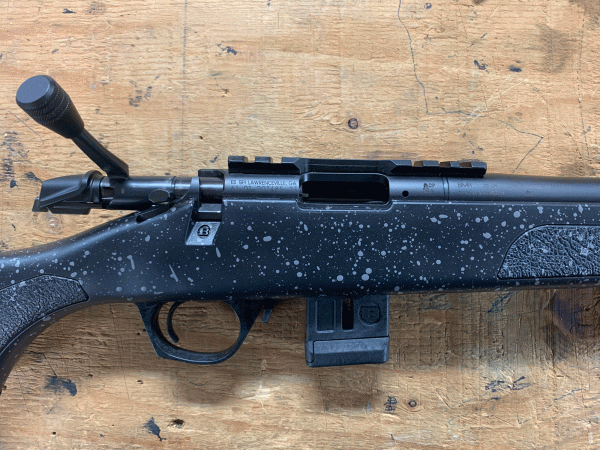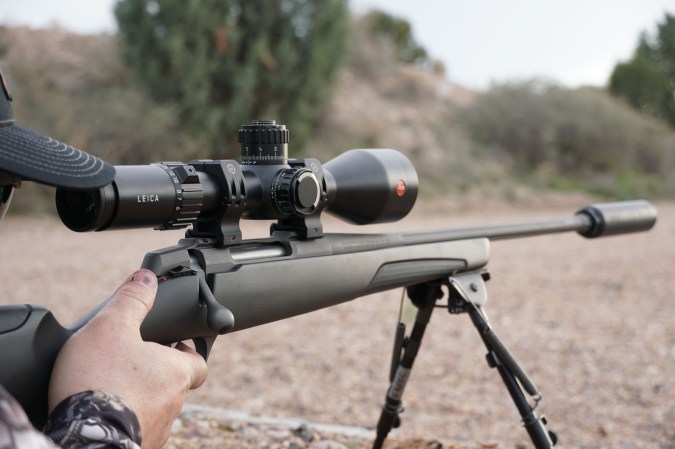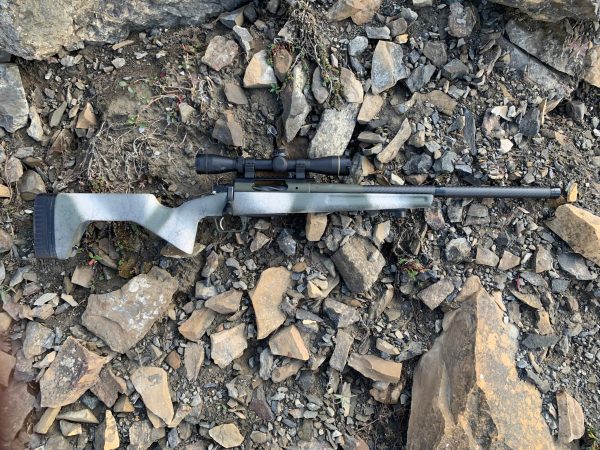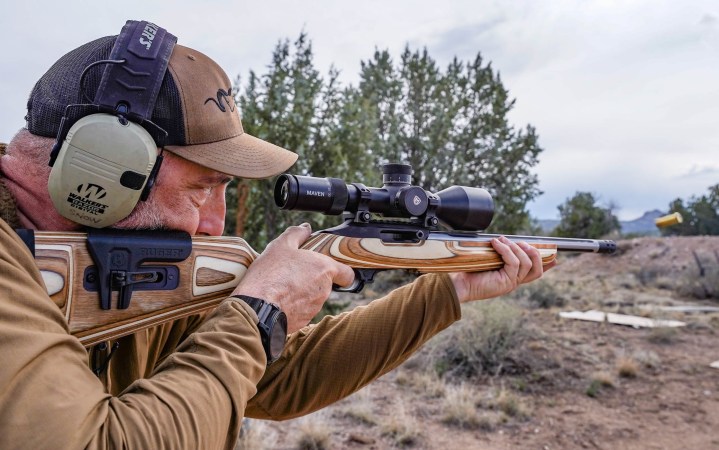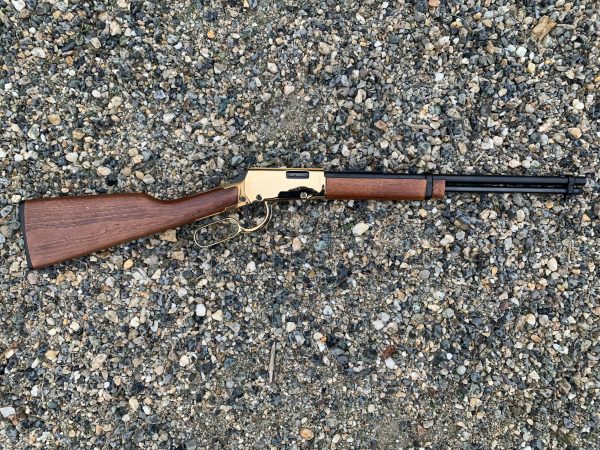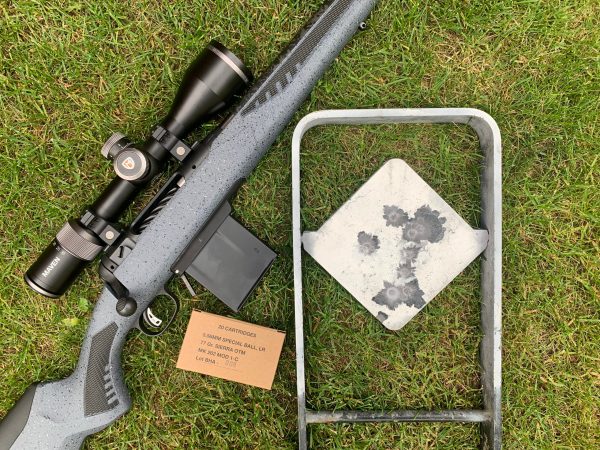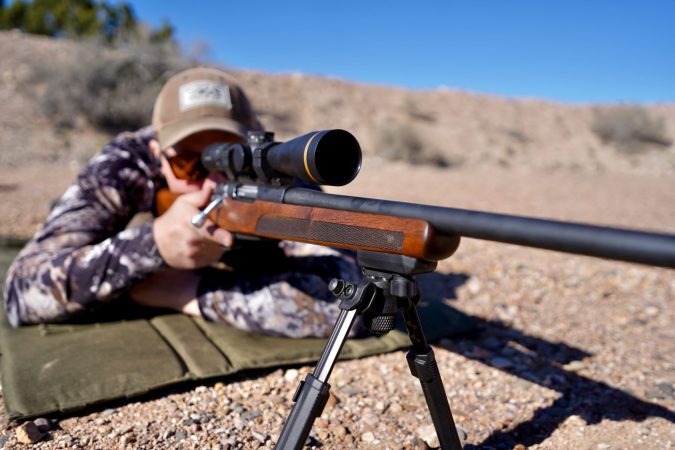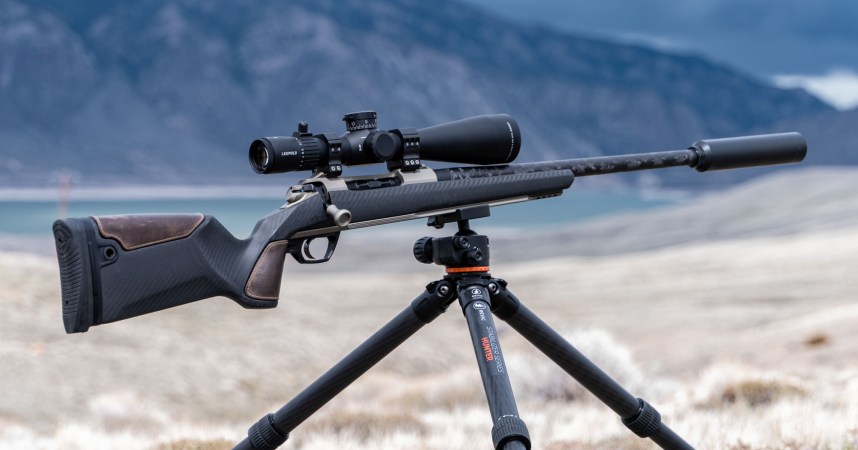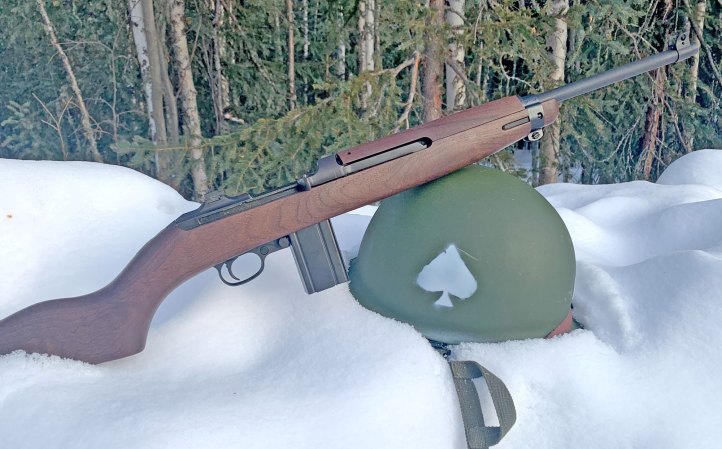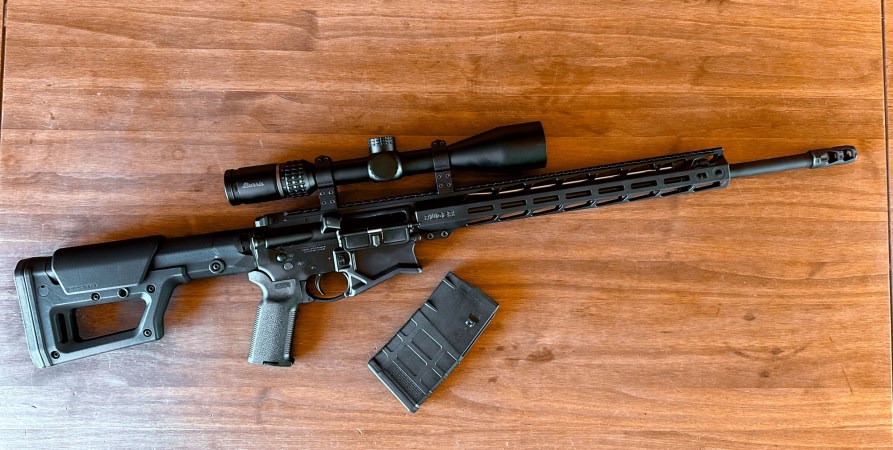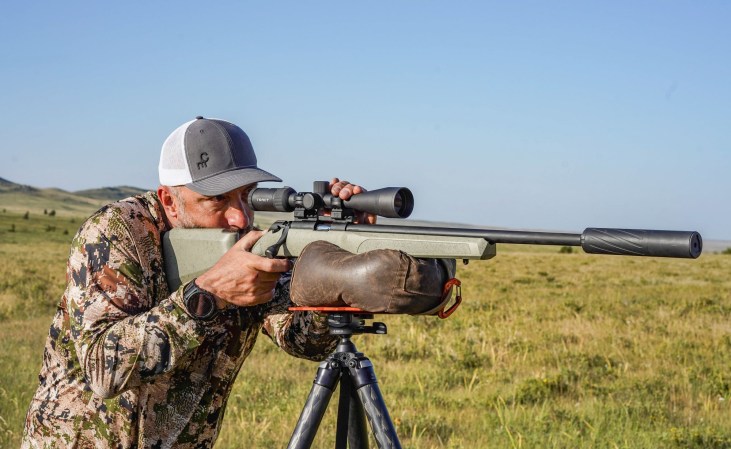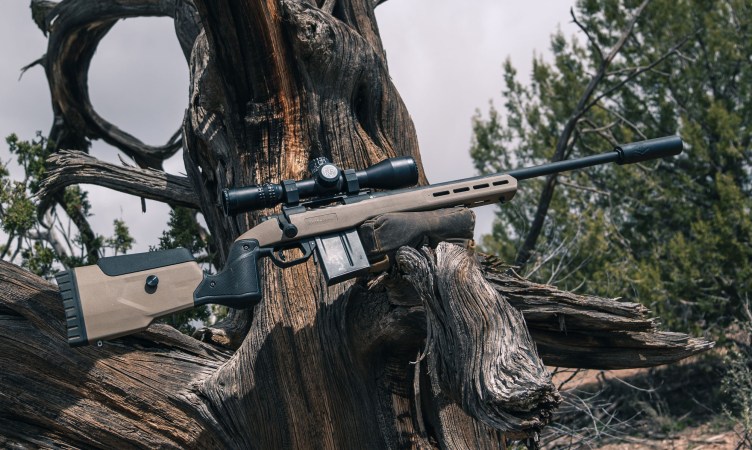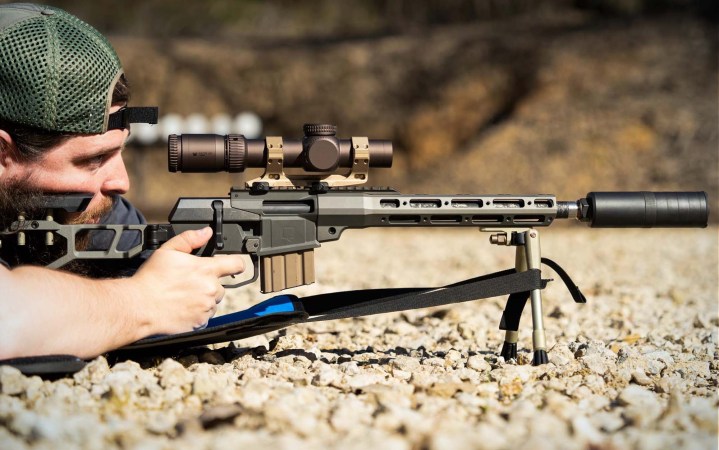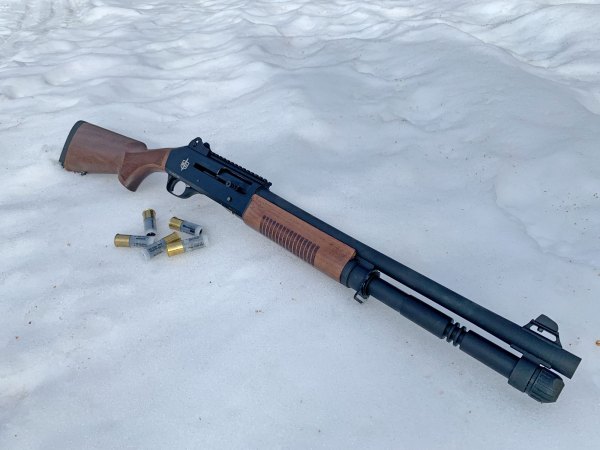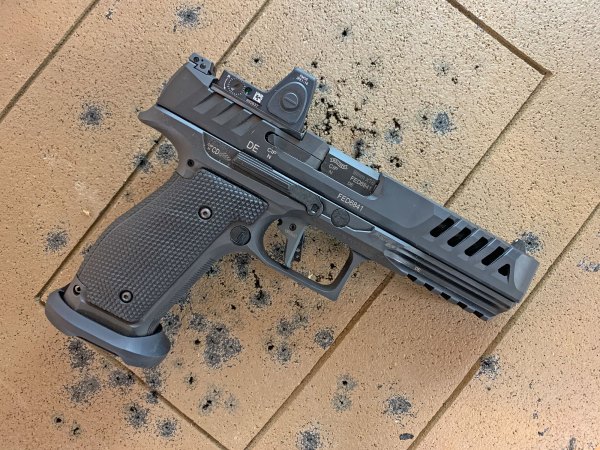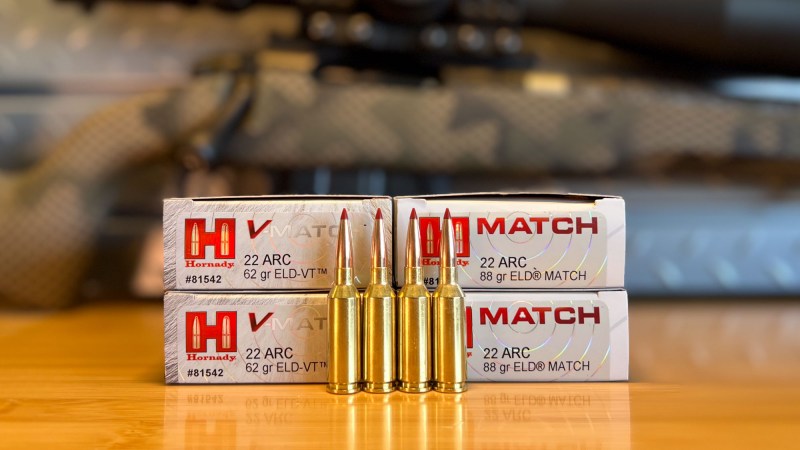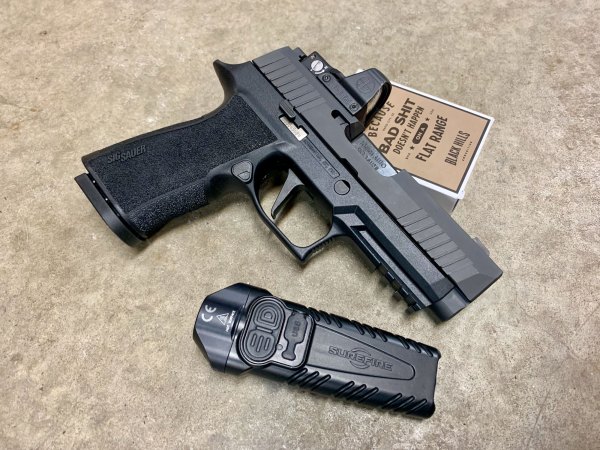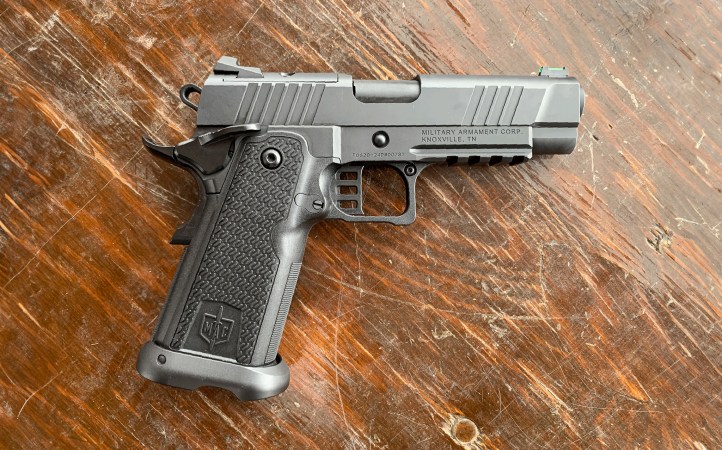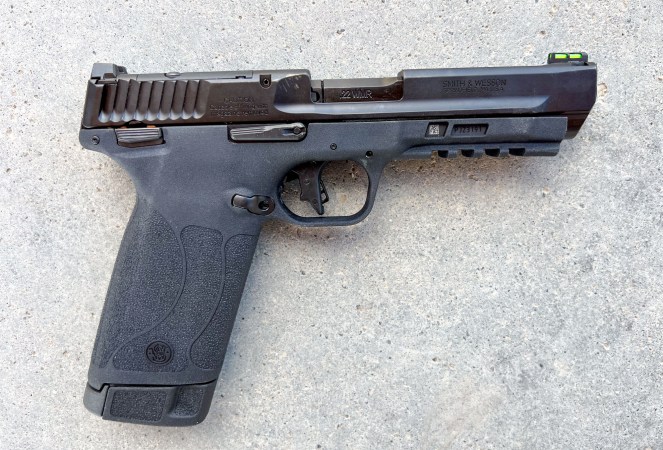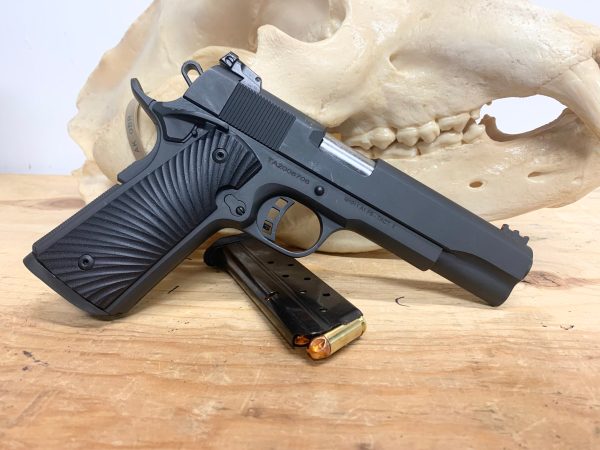We may earn revenue from the products available on this page and participate in affiliate programs. Learn More ›
There is nothing that balances marksmanship with fun and ammo affordability better than a .22 rifle, and the Hammerli Force B1 folds all that into an adjustable, modular, biathlon-style rifle. You and I might not be clicking into our cross-country skis to clean plate racks, but we don’t need to spend north of $6,000 to experience the fun and style of an olympic-grade rifle either. Though the target-style vertical grip and large straight-pull handle are instantly noticeable, the Hammerli Force B1 is packed with features that make it appealing to a wide variety of rimfire hunters and plinkers.
Hammerli Force B1 Specs
- Cartridges: .22 LR (eventually .22 WMR)
- Barrel: 16.1 inches, muzzle threaded ½-28
- Receiver: Aluminum, black finish
- Stock: Polymer, adjustable LOP and comb
- Trigger: 5 pounds, 4 ounces (measured)
- Weight: 5 pounds, 5 ounces (measured)
- Length: 35.5 inches to 37.4 inches
- Price: $600
Key Features
- Straight-pull bolt action operation
- 10/22-style receiver and rotary magazines
- Picatinny optic rail
- Push-button length-of-pull adjustment
- Extended magazine release
- Quick-detach barrel
- M-Lok rail on forend
- Q.D. rear sling socket
Review Highlights
- Fast operation
- Good ergonomics
- Cool, user-friendly features
- Lots of fun to shoot
- Case ejection isn’t robust
- Potential caliber switch option is cool
- Accuracy: 1.605 inches at 50 yards (average of 38 5-shot groups with 6 types of ammo)
Hammerli Force B1: A Straight-Pull With 10/22 Inspiration
Straight-pull bolt-action rifles have never been wildly popular in the U.S., but they offer speed and stay-on-target stability that regular bolt actions don’t. One of the reasons biathlon racers use them is to quickly and precisely engage a series of targets while standing on skinny cross-country skis. Though it’s not as expensive or high-performance as pro rifles like the Anschutz 1827F Bionic, The Hammerli Force B1 is built in the same spirit.
This new straight-pull is designed with roots in the Ruger 10/22, and uses the 10/22 rotary magazine. I would be amiss if I didn’t point out its resemblance to the Volquartsen Summit .22 rifle, which has been around since about 2017 and is a similar 10/22-inspired straight pull. Though they look quite similar, there are a number of key differences, and the Hammerli — manufactured by Umarex in Germany — is a bit more affordable.
The Hammerli Force B1 Action
The most defining feature of the Hammerli Force B1 is its straight-pull action. Behind the 10/22-like ejection port in the aluminum receiver is a slot from which the large vertical bolt handle extends. To open the action or eject a spent case, I simply pull the handle to the rear. A rotating linkage which connects the bolt handle to the bolt draws the bolt backward, pivoting outside that slot in the receiver. This cocks the trigger and ejects the spent case. When pushed forward, the linkage drives the bolt forward, chambering a fresh cartridge, then the linkage clicks back into a straight position behind the bolt, locking it into battery.
The bolt handle is long enough to use two fingers to pull it to the rear, but I found that simply using my trigger finger to operate the bolt was easy and incredibly fast. I can fire, operate the action, and fire again, while keeping the pad of my thumb cemented to the vertical grip. In fact, it’s the vertical grip that allows for both a good trigger pull and intuitive, efficient operation of this action.
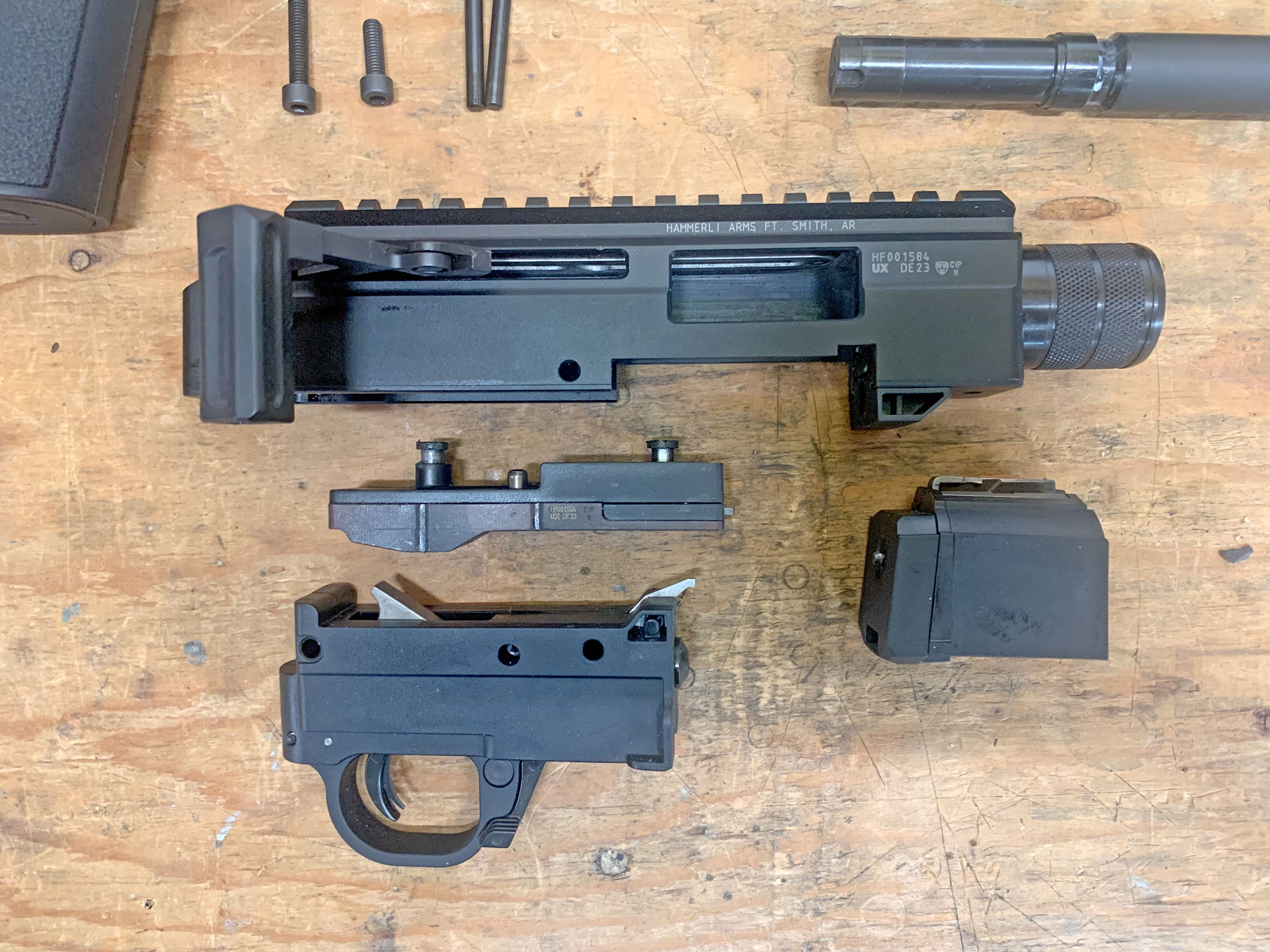
The bolt cycle isn’t entirely smooth, and there are basically three different resistance “bumps” to overcome:
- Dislodging the bolt from its battery position
- Ejecting the case
- Locking the bolt back into battery
The key to running this rifle smoothly and quickly is to drive it with authority. Because this gun uses a fixed ejector — one that relies on rearward speed of the bolt to eject the spent case — slow or soft operation of the bolt will cause a failure to eject, and you’ll have to clear the gun. Even when running fast, I noticed ejection to be less than robust.
One thing I really appreciate is the extended magazine release that has tabs on either side of the trigger guard. These tabs are low-profile, but allow the shooter to reach with the trigger finger and not break grip. Because the lever that actually pivots and releases the magazines is long and offers a lot of leverage, magazines can be dropped free effortlessly — unlike the standard 10/22 style mag catch.
Quick-Change Barrel
The second-most defining feature of the Hammerli Force B1 is its quick-change barrel design. This differs significantly from the 10/22-type barrel attachment, or that of the Volquartsen Summit. The barrel attaches to the receiver via a ball-bearing and sleeve locking system that works the same way as air compressor fittings. To remove the barrel, the sleeve is drawn back from the ball bearings, allowing them to release the barrel. Simply pull the barrel free. To install the barrel, pull the sleeve back, press the barrel into the fitting with its indexing notch at 12-o’clock, then slide the sleeve forward, back over the ball bearings. The bearings fit snugly into a groove in the barrel itself.
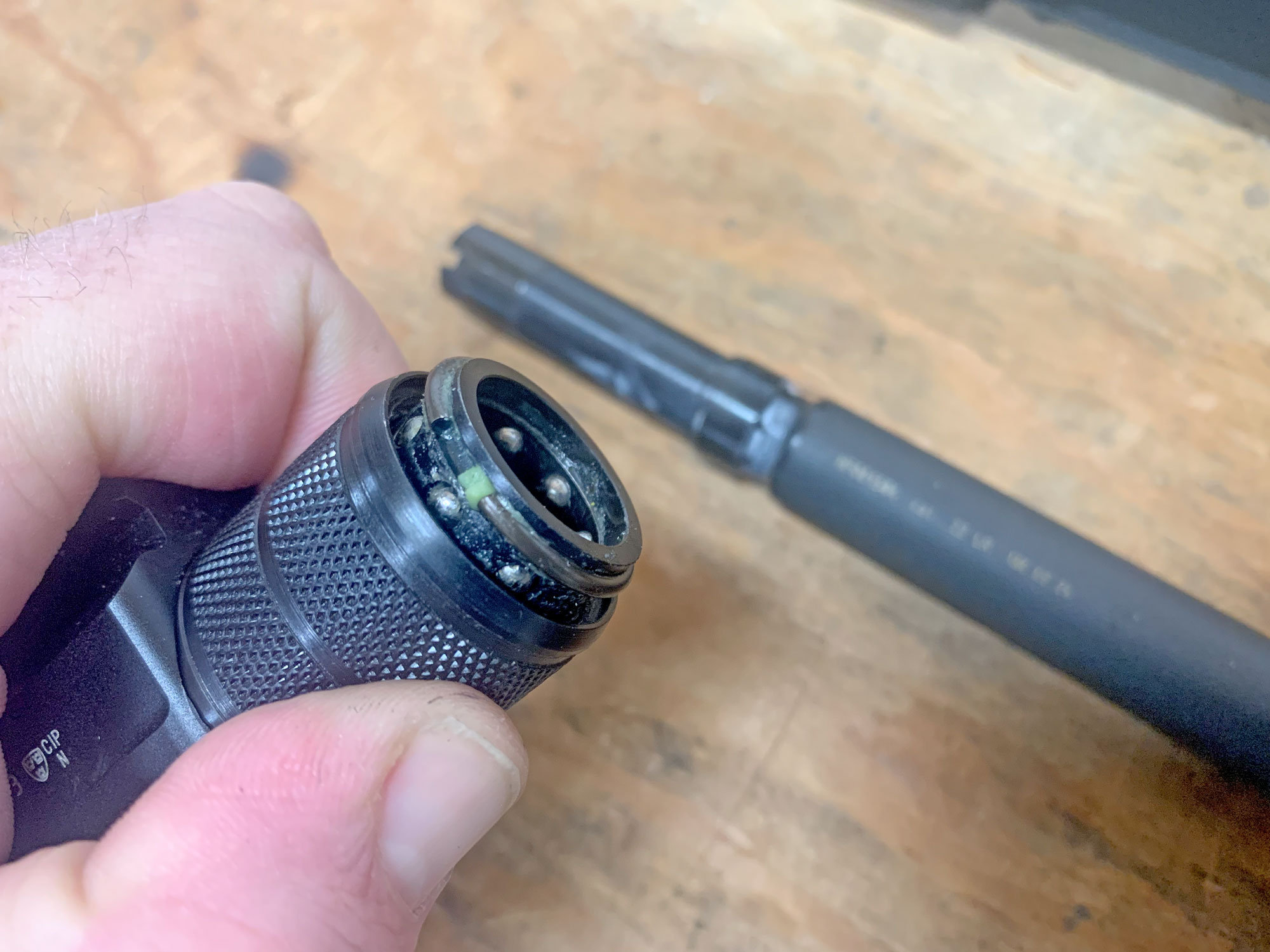
The indexing works in a similar way that an AR15 barrel extension interfaces with the receiver, except that it’s backwards. An AR barrel extension has the pin, and the receiver has the notch. The Hammerli barrel has the notch and the receiver has the pin.
This system seems to work well, and the bearings are lubed with a grease that looks (and smells) like Bore Butter muzzleloader lubricant. The idea behind this quick-change feature is to make it easy to swap between .22 LR and .22 WMR barrels — which aren’t available yet. The receiver and magazine well are made to accept Ruger rotary .22 WMR magazines, and to accommodate the .22 LR mags, Hammerli includes a small spacer that clips onto either the 10-round or aftermarket extended magazines.
I have an inherent distrust of quick-change-fitting barrels. I’ve seen twist-lock .22 rifles that would show impact shifts of several inches at 50 yards each time the barrel was removed and reinstalled. I tested this with the Hammerli by firing two 10-shot groups at 50 yards, which I would then correlate into a 20-shot group. Then I pulled and re-installed the barrel and repeated the test. I did this three times, and though I did see a shift of my mean point of impact by about .26 inches, it’s arguably within the variability of that sample size. I’m sure there is some impact shift, but it’s not demonstrably significant. I do, however, believe that the quick-change feature probably degrades the overall accuracy of this system at some level.
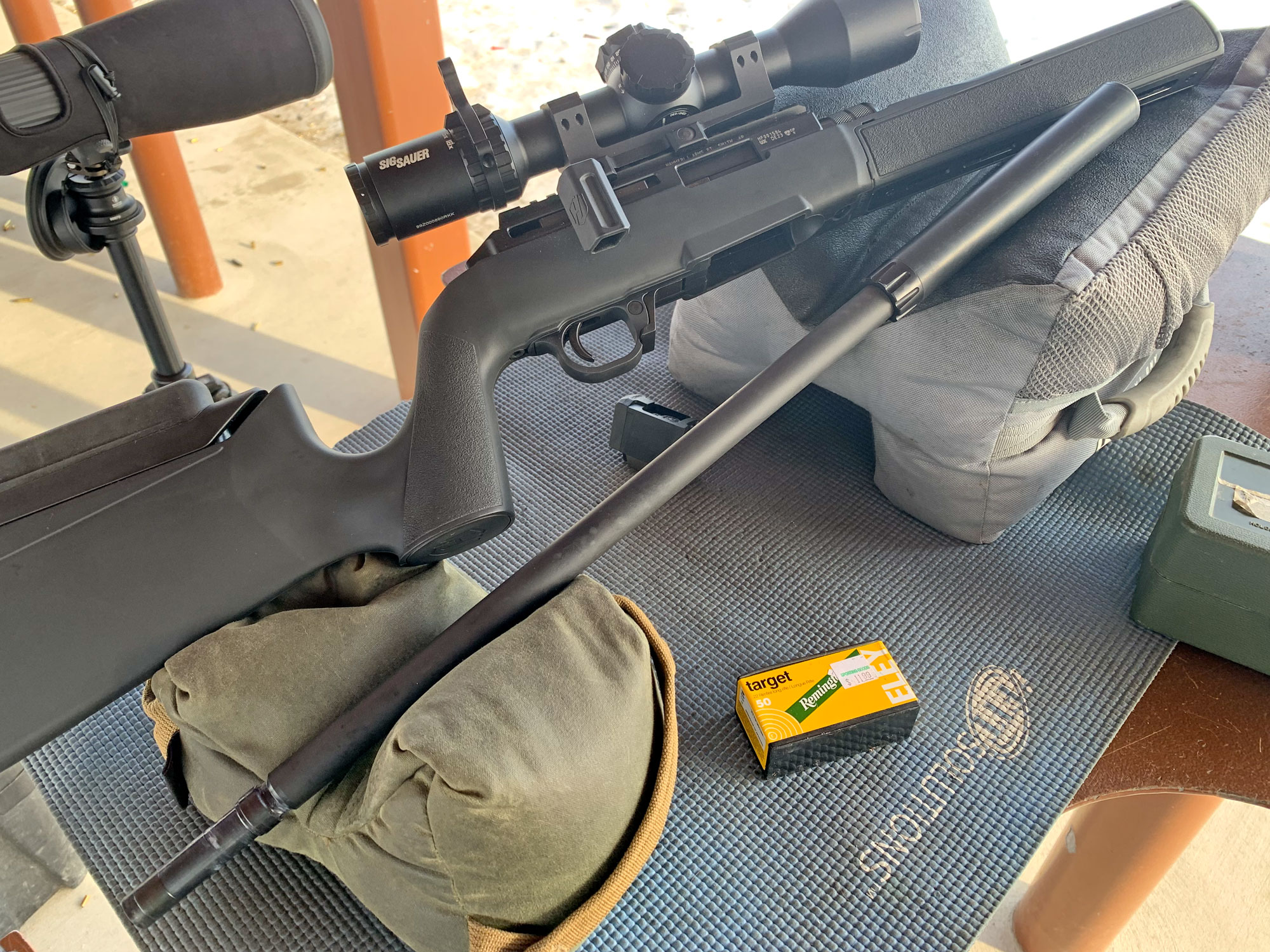
Trigger Compatibility
The trigger that comes on the Hammerli Force B1 isn’t bad. At 5 pounds, 4 ounces, it’s pretty heavy, and I’d prefer a slightly wider trigger shoe. The stock trigger group housing is also polymer, which you may or may not like. The good news for tinkerers is that this trigger group is directly interchangeable with Ruger 10/22 trigger groups — of which there are numerous aftermarket and customization options. It’s an obvious easy button to push with this rifle.
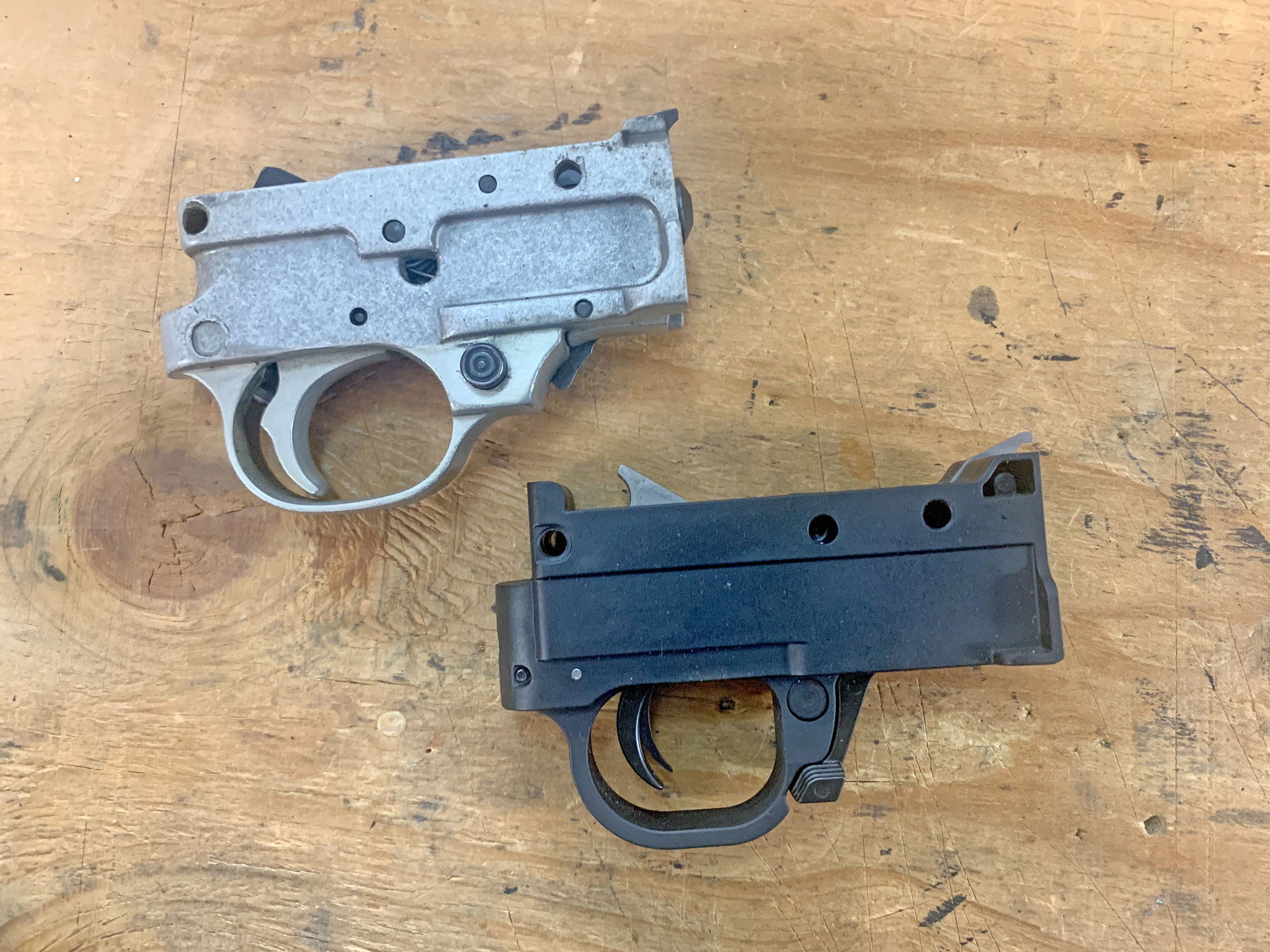
Optic and Suppressor Options
As any modern .22 rifle should, the Hammerli Force B1 comes with a Picatinny rail machined right into the top of the riser for mounting red dots or magnified optics. The muzzle is threaded in the standard ½-28 pattern and capped with a knurled thread protector that fully encapsulates the muzzle. The front of the thread protector cap stands off the end of the muzzle by about a quarter inch, but that small chamber doesn’t seem to affect accuracy or point of impact.
The Hammerli Force B1 Is Versatile with Thoughtful Features
What initially seems like a simple, low-cost synthetic stock on the Hammerli Force B1, turns out to be packed with useful features. We’ve already covered the vertical pistol grip, but the buttstock has two major adjustability components. The comb is adjustable to be used with lower and higher-mounted optics via a reversible rubber insert that fits tightly into the buttstock. Out of the box, it fits flush with the rest of the stock — great for a low-mounted reflex red dot. But pull it out, flip it over, and you’ve got a taller comb for using optics with a riser, tall rings, or a cantilever mount.
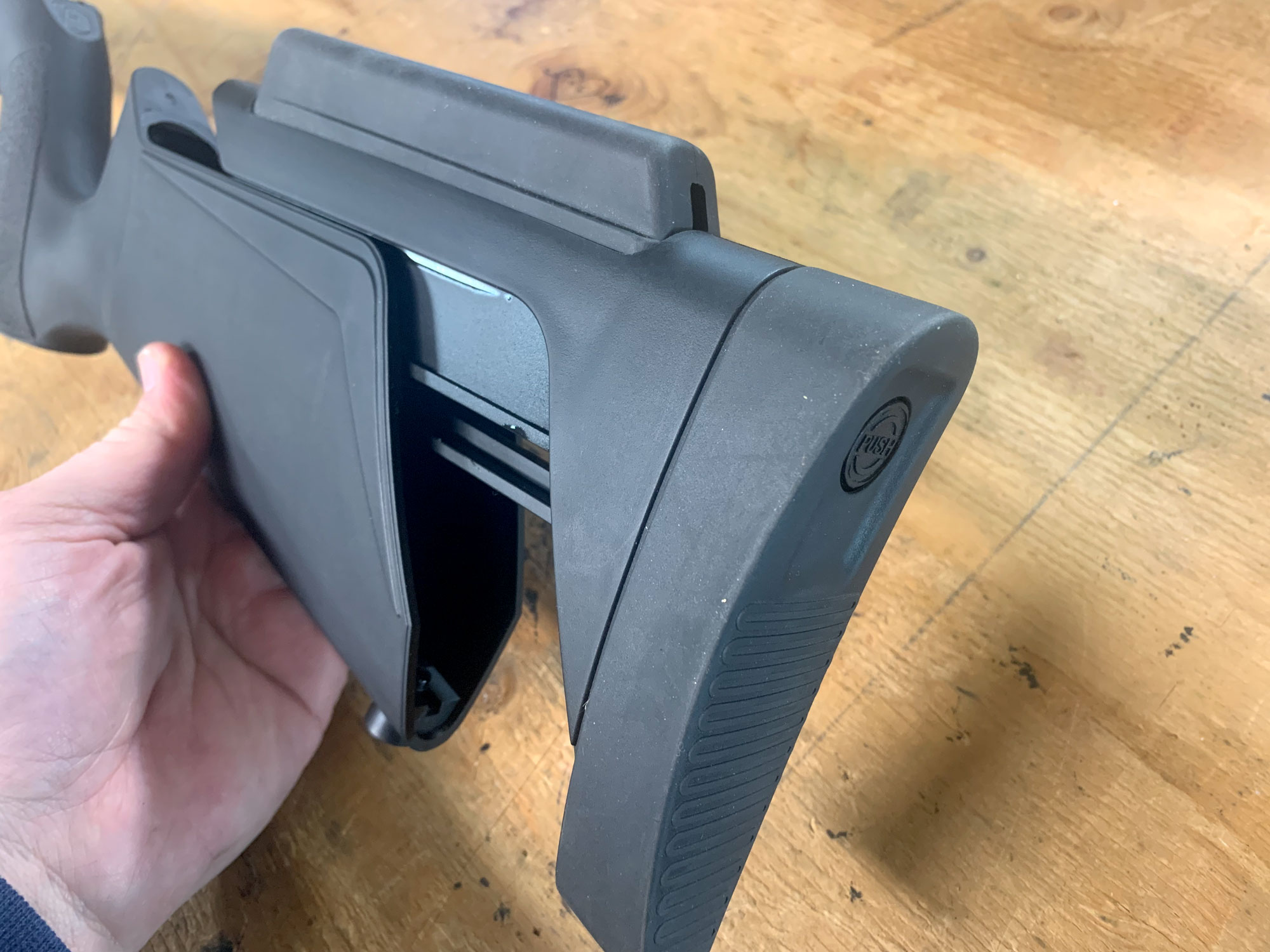
The buttstock has a large adjustment range for length of pull, and can be moved by pressing a button that’s countersunk in the recoil pad. The button lifts a locking lever, and you can slide the butt to the rear to whichever of the six locking positions fits you best. Also embedded in the buttstock is a QD sling attachment cup, rather than a traditional sling swivel stud.
Up front, the simple-looking forend features textured panels on the sides for grip, and a flat bottom that incorporates a section of M-Lok rail. You can attach a section of picatinny, vertical grip, bipod, or even a section of ARCA rail if you’d like. A front QD sling cup isn’t included, but you could easily add one. The stock comes with this M-Lok rail and, though other accessories and variations aren’t available yet, I can see that the stock is designed to accept different grip panel configurations — including M-Lok mounting on the sides.
The versatility and ergonomics of the stock make it great for a variety of positions and supports. It’s easily run from a tripod, bagged on a barricade, or offhand.
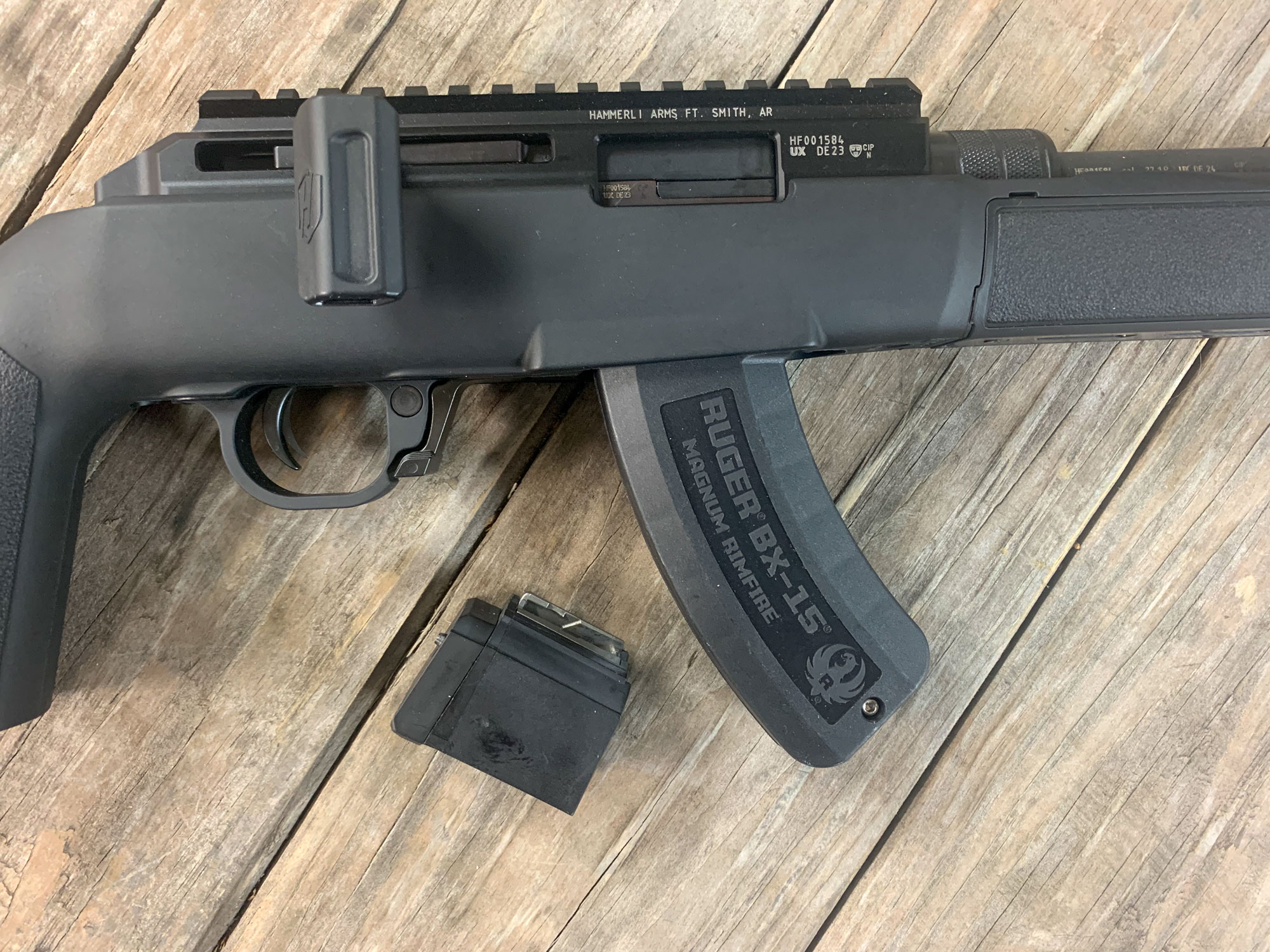
Hammerli Force B1 Accuracy
It’s a given that .22 rimfire rifles aren’t generally carrying the torch for extreme accuracy and, in the words of a friend and former NCAA champion smallbore coach, it’s amazing that we can make good-shooting rifles at all with the inconsistencies in .22 LR ammo. That being said, I was a little underwhelmed by the accuracy of the Hammerli Force B1. I did my accuracy testing from 50 yards, using 5-shot groups as a base increment for evaluation, and compiled 20-shot groups with the most accurate ammo tested.
At Outdoor Life, we’ve long used 5-shot groups to gauge accuracy, but we’re also striving for constant improvement of the information we give you. We test guns hard, and we don’t cut them any slack. Most importantly, we’ve started using larger sample sizes and metrics like mean radius to provide a more informative picture of what each gun’s accuracy really looks like. Here are some of the 5-shot accuracy results:
| Ammo | 5-Shot Average Group Size (50 yards) |
| Remington Eley Match | 1.145 inches (10 groups) |
| CCI Stinger | 1.368 inches (6 groups) |
| Wolf Match | 1.510 inches (8 groups) |
| CCI Standard Velocity Target | 1.585 inches (5 groups) |
| CCI Mini Mag | 2.053 inches (4 groups) |
| CCI Green Tag | 2.623 inches (5 groups) |
| Total Average | 1.605 inches (38 groups) |
Here is the data collected on 3 20-shot groups with the most accurate ammo:
| Ammo | 20-Shot Group Size | Mean Radius |
| Remington Eley Match | 2.563 inches | .520 inches |
| Remington Eley Match | 2.221 inches | .586 inches |
| Remington Eley Match | 1.261 inches | .376 inches |
Self-Calibration and Accuracy Oddities
Obviously, the Hammerli Force B1 isn’t spitting out groups that would win NRL .22, benchrest, or positional competition, but we probably shouldn’t hold that against the rifle. There are some accurate .22 rifles out there, but how does the Hammerli stack up against an unquestionable classic, the 10/22? My stainless 10/22 carbine — the first gun I ever got under the Christmas tree — was perfect to compare it to. I’d never actually recorded good data from my 10/22, and was surprised to see that it wasn’t quite the knot-buster that I’d thought it was. Here’s how they compared:
| Ammo | Hammerli Avg 5-Shot Group | Ruger 10/22 Avg 5-Shot Group |
| Remington Eley Match | 1.145 inches (10 groups) | 1.169 inches (3 groups) |
| CCI Standard Velocity Target | 1.585 inches (5 groups) | 1.946 inches (5 groups) |
| CCI Green Tag | 2.623 inches (5 groups) | 2.160 inches (4 groups) |
With the 10/22 sort of recalibrating my expectations, I think that the Hammerli shoots pretty well for having a quick-change barrel — certainly not worse than the 10/22 on average. If that’s good enough for generations of shooters, it’s good enough for me.
A trend I noticed is that the Hammerli would print different average group sizes with and without a suppressor, and there wasn’t a clear universal advantage for either — I think it just depends on the particular ammo.
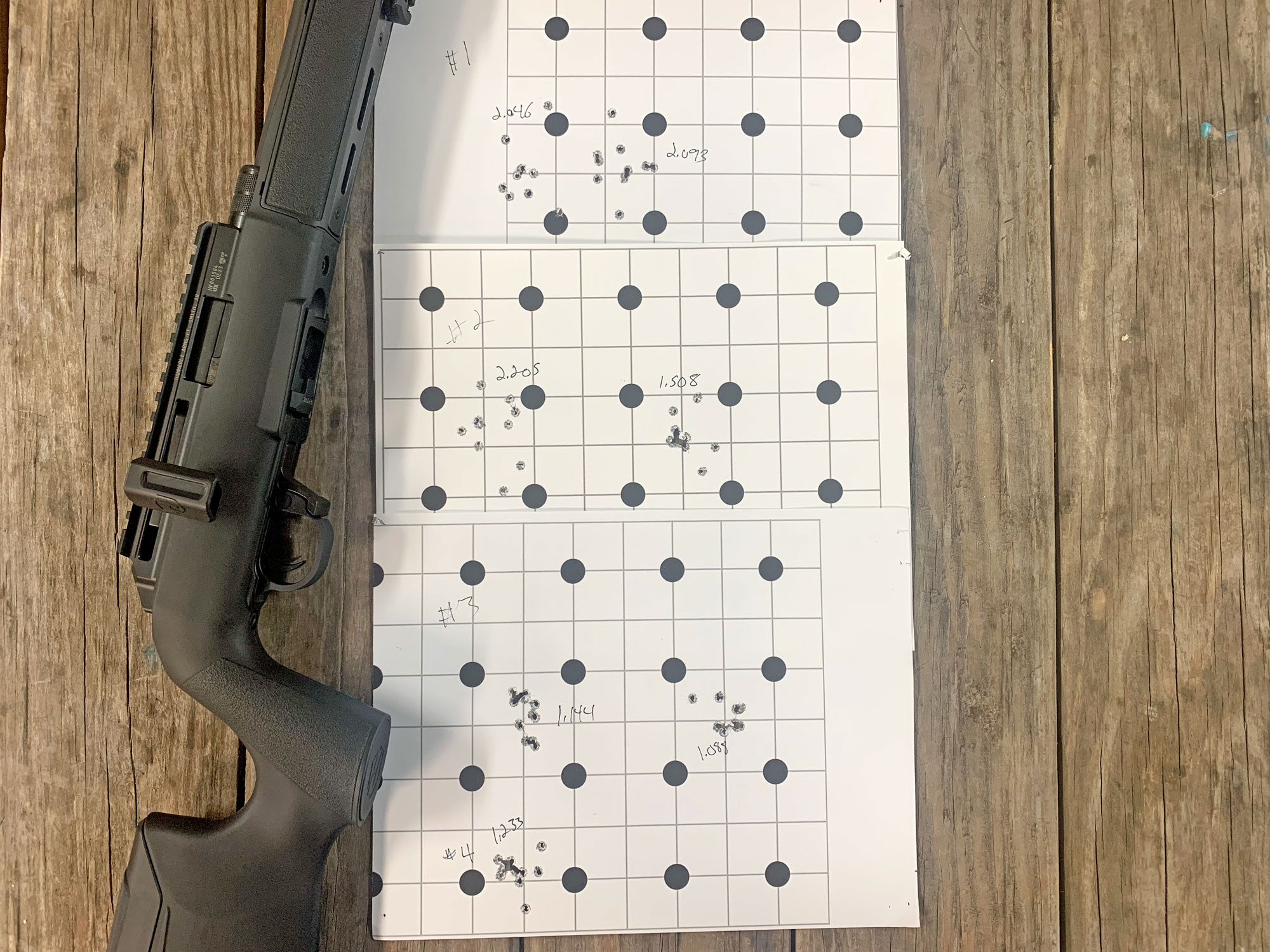
The most interesting trend I saw — though not conclusive — was at the end of my testing when firing 10-shot groups (to correlate into 20-shot groups) with the Remington Eley ammo through a suppressor to check for repeatability when changing the barrel. After a couple groups were fired, shots tightened down significantly. I continued to fire 10-shot groups to see if this trend would go away, but it seemed to hold. They dropped from consistent 2-inch-range 10-shot groups, to 1- to 1.5-inch groups. The only potential variable difference was additional fouling accumulation. The largest shift seemed to be between groups, not directly after a barrel change. I can’t say that shooting a whole box of ammo through the gun will make that ammo suddenly shoot better, but something seemed to change —and I ate up the rest of that stash of ammo chasing it.
| 10-Shot Group Number (In Order) | Group Size (inches) |
| 1 | 2.046 |
| 2 | 2.093 |
| 3 | 2.205 |
| 4 | 1.508 |
| 5 | 1.144 |
| 6 | 1.088 |
| 7 | 1.233 |
What the Hammerli Force B1 Does Well
The Hammerli Force B1 provides a quick-cycling, cool, straight-pull action at an attainable price for many shooters. It’s fun, has good ergonomics, adaptability, and great customization potential.
Where the Hammerli Force B1 Could Be Better
I’d love to see a bit better accuracy from this rifle, but it’s not bad. I think that if I’d designed the gun, I’d probably have chosen a simpler, more sturdy barrel attachment system that still gives the user the option to swap tubes easily. I think that the $600 price tag is fair, but pushing it.
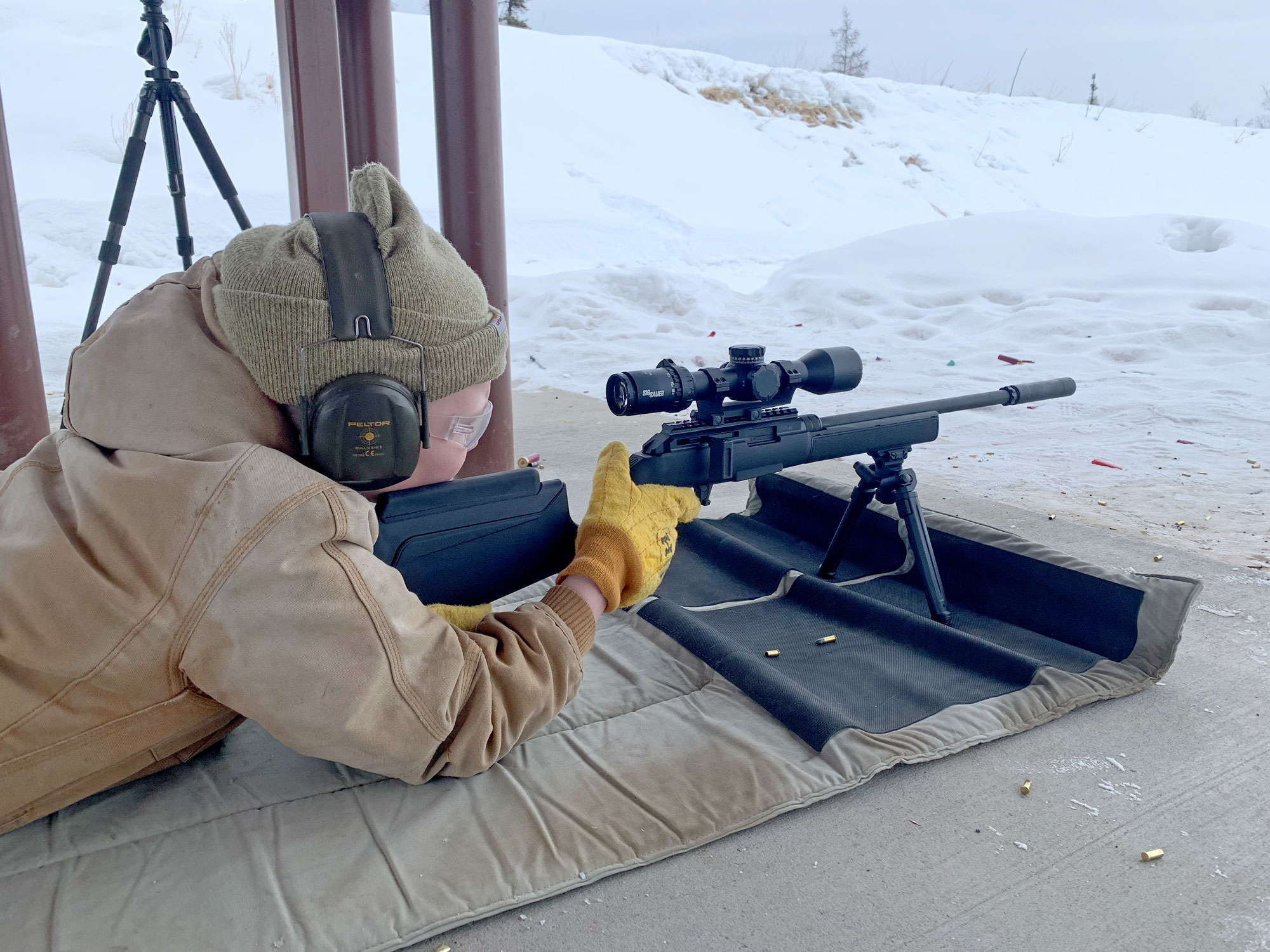
Final Thoughts on the Hammerli Force B1 .22 Rifle
This is a cool little rifle that’s right in the wheelhouse for anyone who likes to tinker and customize their guns. It’s fast and intuitive to run, and can accommodate a variety of shooter sizes, shooting styles, and optics. This rifle is a blast to run on plates from a bipod or bagged on a barricade. It’s not cut out for pinging KYL racks or small targets at 100+ yards, but neither is a regular 10/22.
This rifle has great potential when considering the eventual interchangeable .22 WMR barrels and other accessories it’s compatible with. Hopefully the magnum barrels become available soon, but as it is, the Hammerli Force B1 is still an interesting and fun modern plinker and small game rifle.



